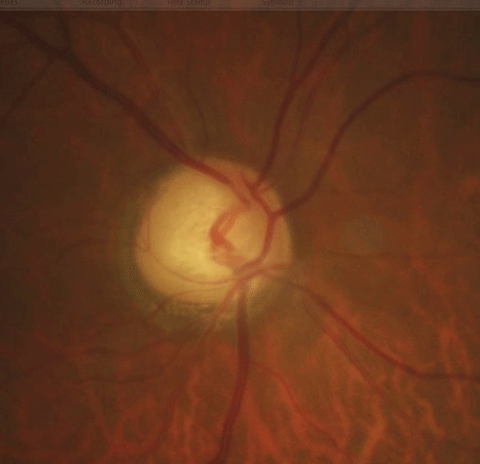 |
|
Within the first three years of therapy, GLP-1 receptor agonists demonstrate a neuroprotective benefit and potential IOP-lowering effects among patients with type 2 diabetes. Photo: Justin Cole, OD, and Jarett Mazzarella, OD. Click image to enlarge. |
Glucagon-like peptide-1 (GLP-1) receptor agonists are rapidly increasing in use across the US for treating patients with type 2 diabetes and obesity. Preliminary research indicates these drugs may offer a protective benefit against glaucoma development through their neuroprotective and anti-inflammatory effects. “These agents have the potential to reduce oxidative stress and enhance cellular survival pathways, which could lower IOP and safeguard retinal ganglion cells,” wrote the authors of a recent study appearing in Ophthalmology, which compared the effectiveness of GLP-1 receptor agonists with metformin as primary treatments in preventing glaucoma.
Using data from 120 healthcare organizations across 17 countries from the TriNetX health research network, researchers compared the risk of primary open-angle glaucoma (POAG), ocular hypertension and the need for primary treatments (eye drops and laser trabeculoplasty) in patients using GLP-1 receptor agonists vs. those on metformin. Outcomes were evaluated at one, two and three-year follow-ups.
After propensity score matching, both groups (GLP-1 agonists vs. metformin) included 61,998 patients at the one-year follow-up, 27,414 at the two-year follow-up and 14,100 at the three-year follow-up. Patients treated with GLP-1 receptor agonists showed a significantly lower risk of developing POAG compared to those treated with metformin, with risk reductions of 41% at one year, 50% at two years and 41% at three years.
GLP-1 agonists also showed similar protective effects for ocular hypertension, with a 56% risk reduction at one year, 57% at two years and 49% at three years. The likelihood of needing first-line glaucoma treatments was also lower among those on GLP-1 agonists, with reductions of 37% at one year, 29% at two years and 25% at three years.
“These findings underscore the potential of GLP-1 receptor agonists not only in glycemic control but also in mitigating the risk of glaucoma,” the study authors wrote in their paper. While the exact mechanisms behind this protective effect have not been fully elucidated, multiple theories have been put forth. “Prior investigations provide compelling insights into the neuroprotective properties of GLP-1 receptor agonists. These agents have been shown to reduce inflammation and oxidative stress by downregulating C1q, TNF-a and IL-1a, which are key contributors to neurodegenerative processes in the retina and optic nerve,” the authors wrote. Additionally, they “improve neuronal survival and function by activating signaling pathways that enhance cellular resilience and reduce apoptotic cell death.” The medication also reduces inflammatory responses in the retina by lowering production of proinflammatory cytokines by microglia/macrophages, thus safeguarding retinal ganglion cells from degeneration, the researchers explained.
The finding that GLP-1 agonists were protective against ocular hypertension also demonstrates their proposed IOP-lowering effect. “A recent study by Hallaj et al. showed that GLP-1 receptor agonists, such as semaglutide and liraglutide, were significantly associated with a decrease in IOP, particularly in glaucomatous eyes,” the researchers noted. Furthermore, another study “demonstrated a reduced incidence of idiopathic intracranial hypertension in patients treated with GLP-1 receptor agonists,” they pointed out.
Glycemic control is also a potential mechanism; it’s possible that improved diabetes management itself could help lower the risk of glaucoma. This couldn’t be evaluated in the present study, since propensity score matching balanced the HbA1c levels between the GLP-1 and metformin groups. However, there is evidence of this theory in existing literature cited by the researchers in their paper, which indicates “poor glycemic control is a significant risk factor for glaucoma development due to the resultant microvascular and neurodegenerative damage from chronic hyperglycemia.”
Finally, weight reduction could play a role in the protective effect of GLP-1 receptor agonists against glaucoma, as studies have linked attaining a lower BMI to decreased IOP.
While studies on the ocular effects of these agents are ongoing, the researchers concluded that these insights “highlight the potential ocular benefits of GLP-1 receptor agonists and their expanding role in the clinical management of diabetic patients.”
Muayad J, Loya A, Hussain ZS, et al. Comparative effects of GLP-1 receptor agonists and metformin on glaucoma risk in type 2 diabetes patients. Ophthalmology. August 2024. [Epub ahead of print]. |


